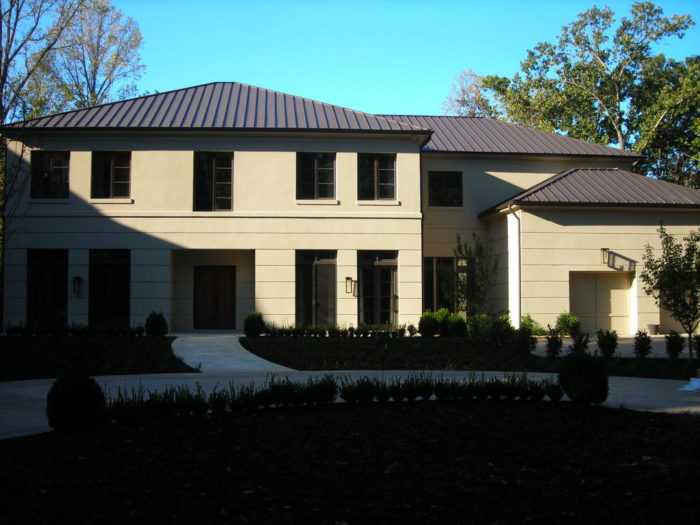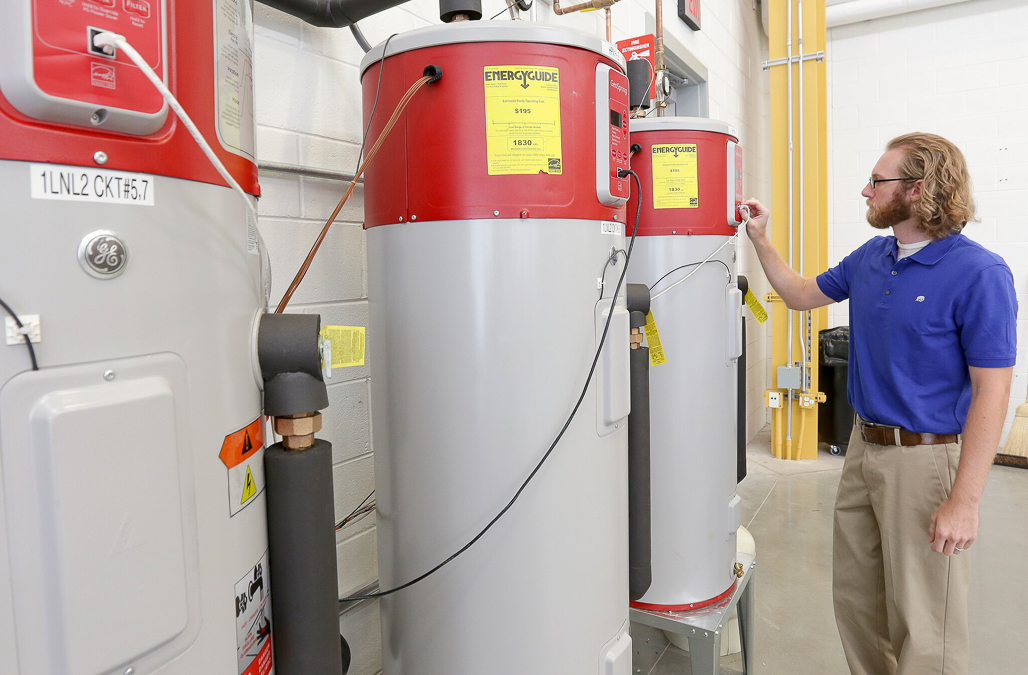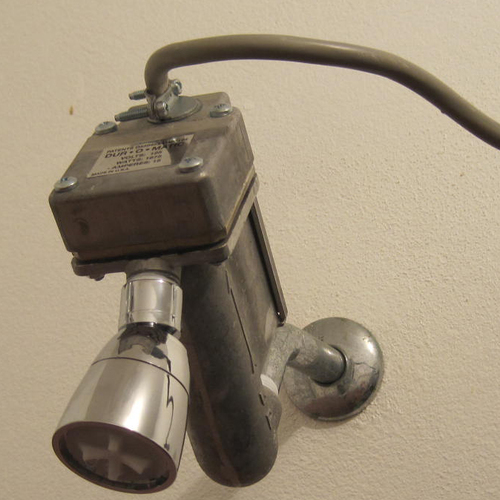Image Credit: Mike LaBelle
I was hired a few years ago to consult on a new luxury residence to make the house as green as possible. At about 7,500 square feet, many people would argue that it could never be a green home, but as I was brought in after the design was complete, my job was to do the best I could with what I was given to work with. While the builder, Mike LaBelle, had no prior experience in high-performance homes, luckily for everyone, he was very interested and enthusiastic about learning how to build better.
We had some very good, open discussions on how this new, high-performance home would work differently than the owner’s existing older home, and the builder, the owner, and I worked together to make the best decisions for the project. ICFs were selected for the wall structure early in the process, primarily for aesthetic reasons. My recommendations included a spray-foam insulated roofline to bring the attic furnace and ducts into conditioned space, solar water heating, high-performance HVAC systems, and an ERV.
So far, so good
Construction went smoothly, and the builder ultimately decided to have the house certified as an EarthCraft House, achieving a HERS index of 56 and meeting the then-available federal tax credit threshold. The owners moved in, and all was well in the world of luxury housing.
After a few months, I heard from both the owner and the contractor that the power bills seemed very high. We discussed possible problems, and I offered to come out to the site to help figure out their problem. Ultimately, the owner hired Southface Energy Institute to investigate the problem.
The culprits
A mechanical engineer from Southface did a thorough review of the energy usage and equipment in the house, and generously provided me with a copy of his report on the house. The heating and cooling loads were appropriately low for a house of this type, but the electrical baseload was through the roof at about 7,000 kWh per month.
Inspections of the existing house systems identified three items that together accounted for over 6,000 kWh of the baseload: a hot water pump, pool pumps, and HVAC supply fans. After the house was occupied, a continuous pump was installed to create a hot water circulation loop to eliminate the wait for hot water in the bathrooms. This pump was installed on the electric backup tank rather than the solar storage tank, causing the electric elements to run continuously as the water was being circulated around the house in an uninsulated line. This accounted for about 4,000 kWh per month.
Two pool pumps — one for filtering, one for vacuuming — were running full time, adding another 1,400 kWh per month. Finally, the owners kept the furnace blowers on full time (not realizing that the ERV provided necessary fresh air throughout the house), adding another 900 kWh to the baseload.
Simple solutions
Recently, the continuous hot water pump was changed out with a timed pump, the pool pumps were set on timers to run only when needed, and the furnace fans were set to auto. Results are not yet in, but it is expected that these changes will help bring the baseload down to a reasonable level and allow the owners to benefit from the high-performance home they live in. I will report on the progress as I learn more.
As the consultant, I was not involved in the pool equipment selection, nor do I have the expertise to make appropriate recommendations in this area. I will, however, research pool equipment for any future projects and share my knowledge with new clients.
I always recommend against hot water circulation loops, opting for demand-operated systems. The pump was probably added at the suggestion of the plumber — a typical solution for long hot water runs, with no consideration of the energy penalty involved.
Keeping the furnace fans on full time may have been a habit left over from the owner’s previous house or possibly a suggestion of the HVAC contractor; in either case, it was a poor decision that added to excess electrical use.
Lessons learned
What I took away from this project is the need for everyone involved to always keep the big picture in mind throughout the process, to maintain open communication, and to avoid making changes and additions in a vacuum. The entire construction team must stay in communication throughout the project and stick to the plan; no one should make any changes unless they are considered in the context of the whole house and its systems. Finally, commissioning of mechanical systems is important but rarely done in residential construction; this situation should change.
Fortunately, the problems with this project proved to be relatively minor and simple to correct. A less-conscientious builder could have made significant changes and created problems with the building envelope or moisture management that would have been complicated and costly to correct. In this case, all that was needed were some minor adjustments, and the only penalty was some wasted energy.
Weekly Newsletter
Get building science and energy efficiency advice, plus special offers, in your inbox.
















9 Comments
Great examples
Carl,
Thanks for writing this blog. These are great examples of energy waste — and such errors are depressingly common.
Variable Speed Drive Motors
Hi Carl: As you research pool equipment alternatives, take a look at the new variable speed drive and two speed pool pumps. These pumps start at high RPM to overcome inertia (technical note: water is heavy) and get the water flow going, then downshift to low RPM to maintain the desired flow rate. Target result=50% saving in electricity with the same or better filtered water quality; significantly less noise; longer pump longevity as the pump runs cooler; less wear and tear on expensive DE filter components. In fact, municipalities in the US where peak electric utility demand occurs during summer (causing power cost issues and blackout risk) should consider outlawing energy-hog single speed equipment. In addition, always design short, fat (2 inch diameter not 1.5) pipes that are straight and without sharp bends. Long, narrow pipes with multiple 90+ degree joints=high internal friction which wastes electricity and wears out the pump. VSD pumps can be plumbed close to the pool as they are much quieter. Lastly, any heating equipment (if specified) should be solar: a properly programmed VSD pump should use little/no more juice to pump low cost unglazed solar pool heating panels=warm pool at zero marginal operating cost.
The small stuff
Great post Carl.
I think it was Jerry Jeff Walker who said: "its the small stuff that's always hanging me up" (or something close to that.)
Yesterday I had a tour of a new construction home here in Maine. Motivated homeowners that want to do it right and are focused on energy, a plan from a "green" architect, and a progressive builder who wants to learn. Everyone on the team with the absolute best of intentions. And they've made a mess.
It's fully framed and sided, windows in, and systems are beginning to be installed. The walls are 12" cavities with offset studs. But they made a last minute budgetary decision to go with trusses for the roof rather than beams. It's a very shallow roof pitch and way too tight at the top plate. They weren't thinking about how they would insulate when they made the truss decision though they assumed a vented attic. They still don't know what kind of insulation they'll use. An HRV system was added at the last minute, and the recovery exhaust is now running through the cold part of the attic. Because they didn't plan for the HRV, the ducting all collects in the owner's "sound proof" music room. They invested in decent windows for much of the house, but not in the central cupola where all the heat will end up.
In your example, at least they had you. In so many projects, there is no Carl Seville to coordinate the team and identify the interdependencies. Like Martin, it's hard not to be a bit depressed.
PT
Are they really "little" things?
Carl,
To repeat, your post is great — except, perhaps, for the title. To an energy consultant, a continuously operating pump for a domestic hot-water loop and two continuously operating swimming pool pumps set off very loud alarm bells. No energy consultant would consider these blunders to be "little things."
What we need are more energy-smart plumbers — plumbers who can catch these big things before they're installed.
Big vs Small
Martin - glad you liked the post. I felt it was important to write it, and hopefully it will get circulated outside the circle of readers and get a broader audience to think about the bigger picture. In terms of the title, in this case the decisions that caused the big problems were relatively small, and, thankfully, easy to correct, rather than big, systemic problems that would have been almost impossible to fix after the fact. Things went very well throughout this project, just a few things at the end, come incorrect assumptions, and poor decisions after the fact made all the difference.
Small at the time
Responding to Martin's big--small point: while those in the know get that how truly big some of these decisions are in a project, far too many don't. In my sorry example above, things like mechanical ventilation and roof insulation weren't deemed big enough to considered early in the plan. Perhaps these aren't big, but huge. It speaks to how much education work is in front of us.
PT
What about HVAC?
Any idea at how much energy the HVAC for the home is using?
HVAC
The engineer's report estimated the following HVAC costs by subtracting the base load from the total utility usage:
Cooling 7720 kWh annually, breaks down to: 0.55 watt hours/sf/cooling degree day (the monthly baseload was 7000 kWh before the corrections)
Heating 969 Therms = 4.05 BTU/SF/Heating degree day.
Little things make a big difference
Looks great! Maybe we can't install a windmill, benefit from solar panels, or rebuild an entirely new green house, but there are a few simple things we can do that make a big difference in energy usage. For example, if you take a look at the flex duct in your attic, it's probably kinked and preventing efficient airflow (like a garden hose). There's a product called SMART Flow Elbow you can snap on (like a brace) that helps - 80% more efficient airflow.
Also something else we added was a "FilterLOCK" on the furnace filter to cover/seal the filter slot. It also protects allergens and dangerous pollutants from entering the duct system.
Just doing these two things reduced our gas bill by $10 a month this winter. We were surprised with the results.
Log in or create an account to post a comment.
Sign up Log in